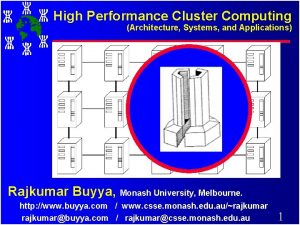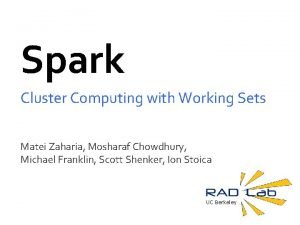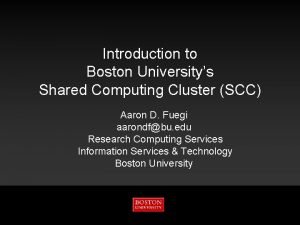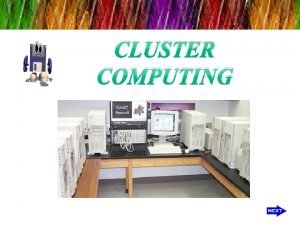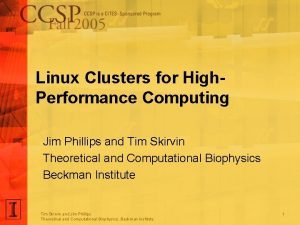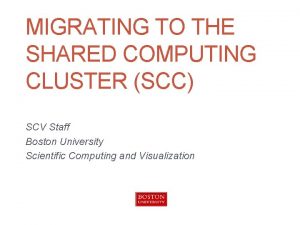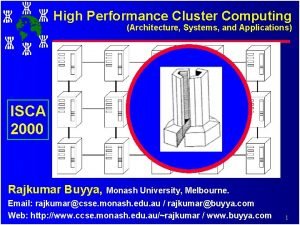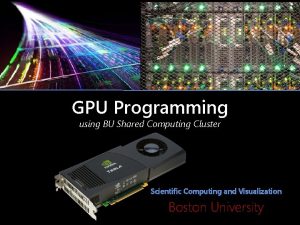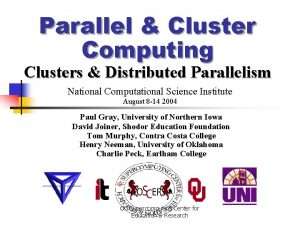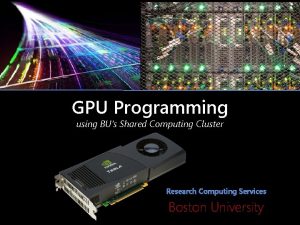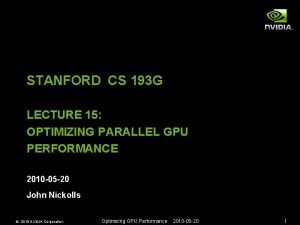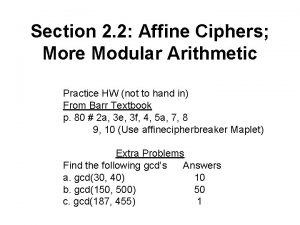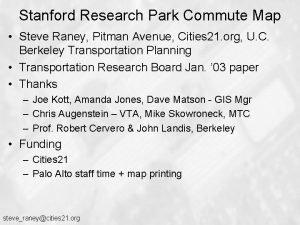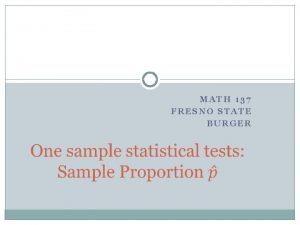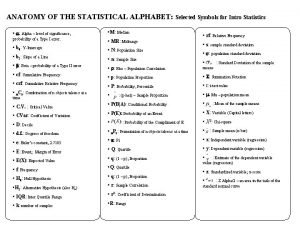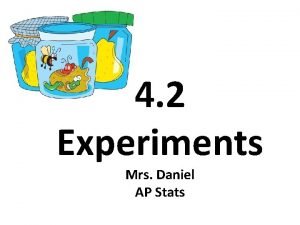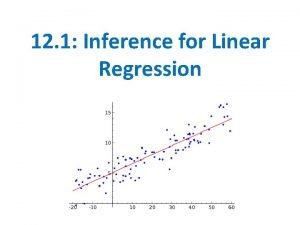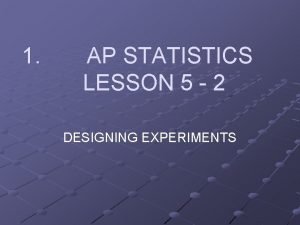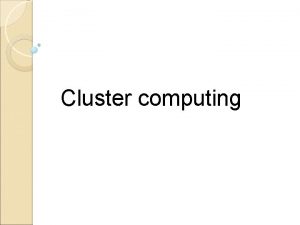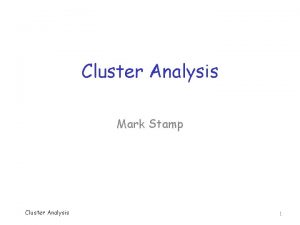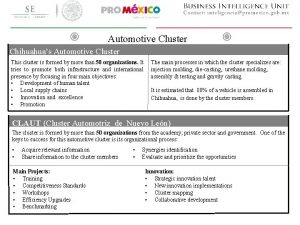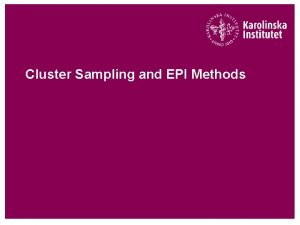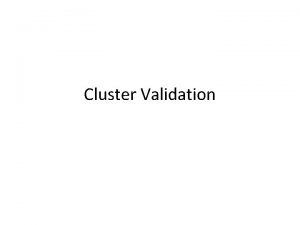Stanford Research Computing STATS 285 FALL 2019 CLUSTER
















































- Slides: 48

Stanford Research Computing STATS 285 FALL 2019 CLUSTER COMPUTING INTRODUCTION AND THE SHERLOCK HIGH PERFORMANCE COMPUTING CLUSTER

Overview • • • Intro to SRCC Overview of HPC Parallel computing HPC/On Prem versus cloud HPC example system: Sherlock cluster SLURM and submitting jobs



5 SRCF: Our Data Center • • • 21, 000 sq. ft. high density secure computing facility. 10 and 100 GB networked ~4, 000 servers Located on the SLAC campus, leading edge energy conservation features 415 V power direct to the server cabinets 100% outside air with all outside air relieved from the space via natural convection (zero fan energy for outside air exhaust).

6 SRCF Data Center An example day. IT load 489 k. W Facility load 582 k. W Racks Servers(nodes) UPS Generators Networking/Fiber Cooling Electrical

What is High Performance Computing (HPC) “HPC generally refers to the practice of aggregating computing power in a way that delivers much higher performance than one could get from a typical desktop computer or workstation in order to solve large problems. ” – Inside HPC A computer cluster is a set of connected computers working together so that, in many respects, they can be viewed as a single system. Clusters are composed of nodes set to perform the same task, controlled and scheduled by software. A distributed system is a system whose components (nodes) are located on different networked computers (via Infiniband, Ethernet), which then communicate and coordinate their actions by passing messages to one other. The components interact with one other in order to achieve a common goalgreater computing power than individual computers. Parallel computing is a type of computation in which many calculations or the execution of processes are carried out simultaneously. Large problems can often be divided into smaller ones, which can then be solved at the same time.

When will I need it? When your computing needs are above and beyond what an average laptop or desktop can handle in terms of data storage, CPU, RAM, i/o, availability and networking. Almost every field of research where simulations, large computation or data is needed: Astrophysics, Machine/Deep Learning, Social Sciences, Biology, Chemistry, Economics. Most common software run: R, Matlab, and Python As far as the user is concerned it’s all about power: [mpiercy@sh-ln 04 login! ~]$ sinfo --format=%C CPUS(A/I/O/T) 23094/1557/701/25352 (allocated/idle/other/total) So- 25, 352 CPUs on Sherlock (ONL’s Summit has 2, 282, 544!)

9 Personal Computers vs. High Performance Computers Mac Book Pro Laptop Typical Sherlock Node • 2 cores (1 CPU) • • 16 GB RAM • 512 GB Solid State Disk 24 CPUs in two sockets Intel 2. 4 GHz Xeon Skylake CPU, up 256 CPUs can be run at once on Sherlock, 8, 192 CPUs for owners. • 192 GB RAM • 20 TB scratch storage, 1 TB group home, 100 GB local Solid State Disk • Infiniband connection 100 GB/s between nodes and storage (Scratch, Oak and Home) • GPU nodes (NVIDIA Kepler K 80, K 40, Volta V 100 ) • Big memory nodes (512 GB, 1. 5 and 3 TB RAM)

High Performance Computing Use Cases § Analyzing Gravitational Lenses 10 million times faster on Sherlock with neural networks on our GPUs, Advancing the automatic prediction of image quality in MRI from unseen sites, Stanford Open Policing project § https: //srcc. stanford. edu/srcc-enabled-publications

Pros and Cons of HPC vs DIY/desktop Pros • Your code/calculations are run on servers that are always on, networked and accessible from anywhere by anyone in your PI group (including off campus collaborators with basic SUNet. IDs) • High performance parallel file systems- fast i/o, 30 TB of group Scratch storage on Sherlock • Much more compute power, hundreds of CPUs, large memory servers up to 3 TB of RAM • Data sharing among research groups is easy, Globus for large data transfers • Data in home directories are backed up (snapshotted) and replicated • The job scheduler handles problems with hardware, hardware/nodes can fail but jobs do not, you launch your jobs and log off Cons • Need to learn how to use a job scheduler and the Linux command line- aka “The Shell” • Jobs go through a scheduler using the Fairshare algorithm since the system is shared by thousands of users; so you need to wait • Sometimes you need to request and wait for software installs, you will not have the same permissions to change/modify the system as you do on your own laptop, desktop or cloud instance, however often users can install software themselves on Sherlock/Farmshare

HPC Workflows Research- Many users working on many problems, constantly changing environment. Jobs are heterogenous, many single CPU jobs or large multi-node jobs, large RAM, all types of jobs and software Interactive- Users login to compute nodes and iteratively test, run their code estimate their codes resource requirements, install/load code dependencies. On Sherlock we use sdev and srun commands for this. When ready, submit the jobs as batch jobs to the pool of compute nodes with sbatch command. Production- Fewer uses, large scale, thousands, or tens/hundreds of thousands of CPUs. The details, resource requirements, i/o, performance, have already been worked out. Static unless major changes to inputs or software, astrophysics, fluid dynamics, weather simulations, predictions. Often rely on MPI and more recently GPUs. Often jobs are running parallel across multiple nodes

Parallel programming paradigms Two issues: Efficient use of CPUs on one process Communication between nodes to support interdependent parallel processes running on different nodes and exchanging mutually dependent data A parallel program usually consists of a set of processes that share data with each other by communicating through shared memory over a network interconnect fabric. Parallel programs that direct multiple CPUs to communicate with each other via shared memory typically use the Open. MP interface. The independent operations running on multiple CPUs within a node are called threads. Parallel programs that direct CPUs on different nodes to share data must use message passing over the network. These programs use the Message Passing Interface (MPI). Finally, programs that use carefully coded hybrid processes can be capable of both high performance and high efficiency. These hybrid programs use both Open. MP and MPI. Two parallel programming paradigms: threads and message passing Two ways to achieve parallelism in computing. One is to use multiple CPUs on a node to execute parts of a process. For example, you can divide a loop into four smaller loops and run them simultaneously on separate CPUs. This is called threading; each CPU processes a thread. The other paradigm is to divide a computation into multiple processes. This causes each of the processes to depend on the same data. This interdependence requires processes to pass messages to each other over a communication medium. When processes on different nodes exchange data with each other, it is called message passing.

MPI Message Passing Interface • Run code across multiple nodes, CPUs, sharing memory • Thousands of CPUs, TB of memory can be used at once • Communication protocol for programming parallel computers runs over 100 GB/s Infiniband network on Sherlock nodes are connected via PCI bus • Most MPI implementations consist of a specific set of routines directly callable from C, C++, Python and Fortran • Standardized and Portable, Open. MP and MPICH Open. MP pragmas are added to code An MPI program consists of a set of processes that share data with each other by communicating through shared memory over a network interconnect fabric. Used in many codes for large simulations, VASP (ab initio simulations), Quantum ESPRESSO, Schrodinger, NWChem, Tensor. Flow Note that you almost will never need to develop Open. MP code, more often you will be simply using it in your data analysis and research career MPI tutorials http: //mpitutorial. com/tutorials/ https: //computing. llnl. gov/tutorials/mpi/

Embarrassingly* Parallel Examples • Searches in cryptography. Notable real-world examples include distributed. net and proof-of work systems used in cryptocurrency. • BLAST searches in bioinformatics for multiple queries (but not for individual large queries). Sequence alignment, Mutation SNP annotation/discovery • Large scale facial recognition systems that compare thousands of arbitrary acquired faces (e. g. , a security or surveillance video via closed-circuit television) with similarly large number of previously stored faces (e. g. , a rogues gallery or similar watch list). • Computer simulations comparing many independent scenarios. • Tree growth step of the random forest machine learning technique. • Convolutional neural networks running on GPUs. • Hyperparameter grid search in machine learning. For embarrassingly parallel problems true HPC with ultrafast interconnects, parallel storage etc. not always needed, but lots of CPUs are. *meaning an embarrassment of riches- the problem is very easy to parallelize sub-problems or tasks are defined before the computations begin sub-solutions are stored in independent memory locations (variables, array elements) the computation of the sub-solutions is completely independent.

Graphics processing units: GPUs highly parallel structure makes them more efficient than general-purpose CPUs for algorithms where the processing of large blocks of data is done in parallel. GPUs can be faster, but within a very limited set of conditions; single precision math operations with a huge amount of arguments per instruction GPU are specialized for compute-intensive, highly parallel computation and designed such that more transistors are devoted to data processing rather than data caching and flow control. For task that can be parallelized • rendering graphics to a screen • running a Monte Carlo Simulation • multiplying matrices for a machine learning algorithm However: code needs to be GPU aware CUDA and Open. CL used to program GPUs directly Sherlock features some of the latest generation of GPU accelerators: the NVIDIA Tesla V 100. Each V 100 GPU features 7. 8 TFlops of double-precision (FP 64) performance, up to 125 TFlops for deep-learning applications, 16 GB of HBM 2 memory, and 300 GB/s of interconnect bandwidth using NVLink 2. 0 connections. Each compute node features 4 V 100 GPUs, and using a completely non-blocking NVLink topology

CPU vs. GPUs have many more arithmetic logical units -ALUs to calculate with. An arithmetic logic unit (ALU) is a combinational digital electronic circuit that performs arithmetic and bitwise operations on integer binary numbers. This is in contrast to a floating-point unit (FPU), which operates on floating point numbers.

HPC and Cloud workflow comparisons (generalizations) HPC- Extremely large sets of data, processing the information in parallel while sharing the data between compute nodes. The data connection between the nodes has to be very fast essentially turning the entire grid of nodes into one single “supercomputer”. This requires expensive hardware: nodes with individually high performance. One application can be run across a large number of nodes- vertical scalability. Cloud (and HPC)- Good for embarrassingly parallel problems. An EPP problem is one in which a data set is divided into pieces which are dispatched to various computers for processing; or, several copies of a smaller data set are distributed across computers to perform different computations on it (e. g. running the application with different parameters). When done, resulting data is re-assembled. Individual computers don’t have to be super fast, the power lies in having a huge number of computers. Several applications (or, copies of the same application) run on several nodes, so horizontal scalability. Run on low cost commodity hardware. Note, these workflows commonly also run on HPC systems- just much faster.

19 Cloud (AWS, GCP, Azure) versus HPC (Sherlock, Farmshare, your on-prem cluster Cloud Pros • Fast access, pay as you go, small up HPC Pros • Usually free or very low cost (for front costs, scalable, not buying users) hardware • Fair amount of free/low cost fast • No need to learn a job scheduler parallel storage i/o is high latencies • No waiting for resources not competing low with hundreds of users for CPUs, RAM • Maintained large research software • You are root/sudo, install anything you stack want (even if it breaks everything) • up/downloading data is free and very • Nice admin UI’s, front ends fast Cons • User support (free) • It costs $$$, sometimes these can get • Mix of GPU/CPU nodes large mem very high, CPU hours and data nodes, 500 GB-3 TB RAM up/downloads will cost • Sometimes does not scale well with the Cons research/experimental paradigm • Waiting for resources • You are root, you can break things and • Learning a scheduler often no one will help you fix them • Not root/sudo can’t install some • Cloud-speak and concepts to learn software • vendor lock-in • Resource limits • Instances run in VMs not bare metal • Cluster concepts to learn

Cloud is getting pretty complex https: //medium. com/google-cloud/the-google-cloud-developer-cheat-sheet-429775 bd 6 d 11

Sherlock HPC Cluster

Sherlock’s user growth since 2015 4, 400 users from 720 research groups, 122 partitions 6 PB scratch, 12 PB long term storage

Sherlock status view

Sherlock System Simple Overview Infiniband interconnect generic nodes sh-ln 01 sh-ln 02 Youconnecting via ssh sh-ln 03 shln 04. . 08 Login nodes /home specialized nodes, bigmem, data transfer (DTN) /scratch 3 PB Filesystems, storage servers 1, 360 compute nodes

Sherlock: Connecting and Networking Internal and External

Common software pre-installed on Sherlock as modules Matlab R Python Tensor. Flow Keras Py. Torch 423 software packages, in 10 categories, covering 58 fields of science, always growing All stored as modules via LMOD$module avail --- math -- numerical libraries, statistics, deep-learning, computer science --R/3. 4. 0 py-keras/2. 1. 5_py 36 (g) R/3. 5. 1 (D) py-numpy/1. 14. 3_py 27 (D) armadillo/8. 200. 1 py-numpy/1. 14. 3_py 36…

Scheduling Jobs Why Do We Need to Schedule a Job? Resource contention between users needs to be balanced. So, the compute resources are managed and workloads are balanced using a job scheduler- SLURM. How Easy Is It to Schedule a Job? Basic concept - tell the scheduler: 1. What resources you need- CPUs, RAM, time, partition 2. What it should do- load modules, run your code 3. Need to request as few resources as you need so your jobs pend for as small a time as possible, profile jobs with top, htop sacct

Fairshare Basically the more resources you use- CPU/RAM/Time/Nodes in a 2 week sliding window the lower your Fairshare score is, the more likely your jobs will wait in the queue. or A resource scheduler ranks jobs by priority for execution. Each job's priority in queue is determined by multiple factors, among them the user's fairshare score. A user's fairshare score is computed based on a target (the given portion of the resources that this user should be able to use) and the user's effective usage, i. e. the amount of resources (s)he effectively used in the past. As a result, the more resources past jobs have used, the lower the priority of the next jobs will be. Past usage is computed based on a sliding window and progressively forgotten over time. This enables all users on a shared resource to get a fair portion of it for their own use, by giving higher priority to users who have been underserved in the past. Sherlock also uses backfill, smaller jobs can go in front of larger jobs, often regardless of the users Fairshare factor, thus increasing our clusters utilization.

Parallel processing A very simple example, you have 384 files to zip#!/bin/sh for FILE in *. fastq; do sbatch -p normal -t 10: 00 --mem=200 --wrap="gzip ${FILE}" done • • Rather than being run serially on 1 or 2 CPU’s on your laptop, on a cluster there are often thousands of CPUs so all 384 files (jobs) are processed (submitted to the scheduler with the sbatch command) at once. The scheduler needs to allocate jobs->resources. File I/O will be faster, clusters use a parallel filesystem, Lustre Can also use SLURM Job Arrays On Sherlock you can run on up to 256 (8, 196 for owners) CPUs at once PSThis is an example of an embarrassingly parallel problem, little or no effort is needed to separate the problem into a number of parallel tasks. There is little or no dependency or need for communication between the parallel tasks or for the results between them.

Parallel Processing SLUR M your program CPU CPU CPU CPU CPU CPU CPU CPU On a cluster multiple tasks can be submitted via a job scheduler to many CPUs and servers at once Pass multiple arguments to your code at once No no need to wait for 2 or 3 cores and limited RAM on a laptop or desktop to be available

Parallel example with SLURM Job Arrays Job arrays offer a mechanism for submitting and managing collections of similar jobs quickly and easily; job arrays with thousands of tasks can be submitted in milliseconds (subject to configured size limits). All jobs must have the same initial options (e. g. size, time limit, etc). Array jobs are usually limited to 1000 steps. Here only one job is submitted to the schedular with 384 array steps. Note the files are named to match array task ID ($SLURM_ARRAY_TASK_ID) # !/bin/sh #SBATCH --job-name=array_zip # Job name #SBATCH -p owners #SBATCH --ntasks=1 # Run a single task #SBATCH --mem-per-cpu=1 gb # Memory per processor #SBATCH --time=00: 10: 00 # Time limit hrs: min: sec #SBATCH --output=array_%A-%a. out # Standard output and error log #SBATCH --array=1 -384 # Array range #Do your work here gzip SRR 062634. $SLURM_ARRAY_TASK_ID. filt. fastq Same thing can be done with parameter values or other arguments to your code Note: The --ntasks parameter is only useful if you have commands that you want to run in parallel within the same batch script, i. e. your code is multithreaded or MPI enabled

srun SLURM tasks- an example of resource control #!/bin/bash #SBATCH --ntasks=1 #SBATCH --time=1: 00 #SBATCH –mem=8 GB ## more options echo hello from $SLURM_JOB_NODELIST Output: hello from sh-30 -02 In SLURM terminology, a task is an instance of a running program. If your program supports communication across computers (MPI) or you plan on running independent tasks in parallel, request multiple tasks with –ntasks= , the default value is set to 1. Programs require a certain amount of memory to function properly. To see how much memory your program needs, you can check the documentation or run it in an interactive session and use the htop command to profile it. To specify the memory for your job, use the mem-per-cpu option. Clusters have defaults to make job submission easier for users.

srun SLURM tasks example cont. change last line to: srun echo hello from $SLURM_JOB_NODELIST Output: hello from sh-27 -[17, 20] hello from sh-27 -[17, 20] A task in SLURM analogous to a process in Unix, i. e. a running instance of a program with it’s own memory and CPU allocation. Task allocations are controlled by the user via SLURM. You can see in the last example that the command was not only run 8 times ( 8 tasks) but run across the cluster on 2 different nodes. Used for multithreaded applications and MPI. SLURM allows a lot of resource granularity. For example if you want one process that can use 16 cores for multithreading use srun with: --ntasks=1 --cpus-per-task=16

Sample Batch Job #!/bin/bash #SBATCH --job-name=test #SBATCH --time=10: 00 #SBATCH –p normal #SBATCH --cpus-per-task=1 #SBATCH –mem=16 GB #below you run/call your code, load modules, python, Matlab, R, etc. # and do any other scripting you want #lines that begin with #SBATCH are directives to the scheduler-SLURM module load python/3. 6. 1 module load py-keras/2. 2. 4_py 36 python my_code. py _______________________________ Edit with vim/nano/vi and save as test. sbatch To run: $sbatch test. sbatch To watch: $ squeue –u $USER Many ways to control jobs as they run, scontrol pause/update, scancel

Matlab multicore example with Matlab’s parfor #!/bin/bash #SBATCH -N 2 #SBATCH -c 32 #SBATCH -t 0 -15: 00 #SBATCH -p hns module load matlab echo $SLURM_CPUS_PER_TASK srun -c $SLURM_CPUS_PER_TASK matlab -nosplash -nodesktop -r "pfor"

Sherlock Partitions Partition- a logical and physical set of nodes in a cluster Partition Number of Nodes normal 84 owners 1, 176 hns 85 bigmem (500 GB-3 TB RAM) 2 gpu 8 dev 2 Your PI’s own nodes (donoho), stat 4, 3 QOS long (--qos=long, the only QOS needed) jobs >2 days <7 days What partitions can I run on? scontrol show partition | egrep -B 1 "Allow. Groups=. *$(id -gn $user). *" | awk -F= '/Partition. Name/ {print $2}’ What’s nodes are on the partition? sinfo –N –p normal --long

Sherlock Filesystems Home and Group Home, backed up, snapshotted and replicated offsite $HOME 15 GB $GROUP_HOME 1 TB Scratch- fast Lustre parallel filesystem, your jobs should write/read here (6 month purge policy, unless you have purchased $OAK space- $50 per TB/year) $SCRATCH $GROUP_SCRATCH 20 TB 30 TB $LOCAL_SCRATCH 200 GB Local to your jobs node, even faster, but gets deleted at the end of your job http: //www. sherlock. stanford. edu/docs/user-guide/storage/filesystems/ rclone, gdrive connections to cloud storage

Sherlock User Limits View the various partition limits with the sacctmgr commandsacctmgr show qos format=Name, Max. TRESPer. User, Max. Submit. Jobs. Per. User, Max. Wall Name Max. TRESPU Max. Submit. PU Max. Jobs. PU Max. Wall -------------------------normal cpu=256 1000 2 -00: 00 dev cpu=4, mem=16 G 2 02: 00 long cpu=32 20 16 7 -00: 00 bigmem mem=3 T 10 1 -00: 00 gpu gres/gpu=8 50 2 -00: 00 owner cpu=99999 3000 7 -00: 00 owners cpu=8192 3000 2 -00: 00 donoho cpu=40, gres/+ 3000 7 -00: 00

Singularity Containers • • • Singularity containers are great if you have code/data with many dependencies that you cannot install on a cluster Build the container as root on your local system then move onto cluster and run https: //www. sylabs. io/docs/

40 Sherlock vs. Farmshare http: //www. sherlock. stanford. edu http: //farmshare. stanford. edu • Available for use by all Stanford faculty and their research teams • Primarily intended for use in coursework and unsponsored research • Work done must be directly related to the faculty member's research. • Anyone with a Stanford ID (SUNet ID) can log in • A set of servers are free and open to all at Stanford doing sponsored research. Faculty can supplement shared nodes by purchasing additional servers, and become an owner • Shared servers • Helps those doing research have a place to test codes and learn about technical solutions to assist in reaching their research goals, prior to scaling up to Sherlock • The owning group will have exclusive use of purchased nodes and access to the over 1, 100 owner compute nodes when idle. › › › › 1, 325 compute nodes 24, 000 CPU cores 1, 195 GPUs 1, 590 TFlops 3, 400 users 547 research groups 109 Owners › › 20 128 GB RAM compute nodes. 4 767 GB RAM compute nodes. 10 128 GB RAM nodes with an Nvidia Tesla K 40. Shared storage for your group or class. Sherlock is approved for Medium Risk. Neither system is approved for use with highrisk data, PHI, or PII.

The HPC Condo Model Sherlock PIs can buy 1 or more nodes (starting at about $7, 500) • • The PI’s group members will have exclusive use of these nodes Access to idle resources in the owners partition of 1, 120 nodes An owner’s group members will be able to use up to 8, 192 CPUs at once in the owners partition However, jobs in the owners queue are preemptible, if the owner of the node you’re running on wants to use those resources, your job is finished. So these jobs need to be checkpointed in some way. Or at the very least you need to be able to logically aggregate the data at that state and restart processing. Currently there are 125 owners on Sherlock with a total of 1, 158 nodes Sherlock node orders -https: //srcc. stanford. edu/private/sherlock-orders

Future Directions- GIUs and ease of use for HPC Tools have been developed in order to make accessing HPC resources much easier. Ohio Super Computing Center has developed Open on Demand. Users can access an HPC cluster’s shell, launch jobs, Jupyter notebooks, RStudio, edit files all within their web browser. http: //openondemand. org/ Access Sherlock via browser https: //login. sherlock. Stanford. edu

Web browser access to Sherlock

How Can I Obtain Access to HPC? Sherlock Your PI or Faculty Sponsor simply needs to request an account http: //www. sherlock. stanford. edu/ Farmshare Everyone with a full service SUNet ID can access: Log into rice. stanford. edu using a SSH client If you have a Mac/PC, open the Terminal application and type: ssh [sunet]@rice. stanford. edu https: //web. stanford. edu/group/farmshare/cgi-bin/wiki/index. php/Main_Page https: //srcc. stanford. edu/farmshare 2 Stanford Genomics Cluster-SCG 4 Very large bioinformatics stack some free use nodes. A charged service of the Genetics Bioinformatics Service Center https: //web. stanford. edu/group/scgpm/cgi-bin/informatics/wiki/index. php/Scg 4_user_guide UV 300 Supercomputer 10 TB of RAM over 360 cores, 4 P 100 GPUs http: //med. stanford. edu/gbsc/uv 300. html

HPC resources for projects with large compute needs XSEDE - Extreme Science and Engineering Discovery Environment a powerful, and robust collection of HPC resources and services, a single virtual system that scientists can use to interactively share computing resources, data, and expertise. https: //www. xsede. org/ Open Science Grid. Facilitates access to HPC clusters. The resources are contributed by the community, organized by the OSG. In the last 12 months, OSG has provided more than 1. 2 Billion CPU hours to researchers https: //www. opensciencegrid. org/

46 Want to Display Your Work 10 x 24’ ? Welcome to HIVE 10 -foot-tall by 24 -feet-wide display with 13440 x 5400 resolution and 72 million total active pixels. Located in Huang B 050 Use multiple displays simultaneously to investigate various aspects of data collection, simulation, and visualization and to zoom in to see detail at previously unheard-of-levels. Free to use for teaching, research by any groups at Stanford. https: //icme. stanford. edu/resources/hive

To Learn More Documentation Sherlock: http: //www. sherlock. stanford. edu/ Farmshare: http: //farmshare. stanford. edu Contact Questions/Answers: srcc-support@stanford. edu SRCC group: http: //srcc. stanford. edu Mark Piercy: mpiercy@stanford. edu

Links https: //hpc-carpentry. github. io/hpc-intro/ https: //www. sherlock. stanford. edu/docs/overview/glossary/ https: //slurm. schedmd. com/ https: //support. ceci-hpc. be/doc/_contents/Quick. Start/Submitting. Jobs/Slurm. Tutorial. html GPUs https: //nyu-cds. github. io/python-gpu/01 -introduction/ https: //insidehpc. com/2017/03/introduction-gpus-hpc/ https: //computing. llnl. gov/tutorials/dataheroes/GPUParallel. Programming. pdf https: //www. youtube. com/watch? v=49 Dz. PT 9 HFJM https: //storage. googleapis. com/pub-tools-publication-data/pdf/43438. pdf https: //medium. com/the-mission/why-building-your-own-deep-learning-computer-is-10 x-cheaper-than-aws-b 1 c 91 b 55 ce 8 c https: //www. top 500. org https: //insidehpc. com/ Distributed Tensor. Flow https: //deepsense. ai/tensorflow-on-slurm-clusters/ SRCC Acknowledged Publications https: //srcc. stanford. edu/srcc-enabled-publications
 Cluster computing architecture
Cluster computing architecture Dr sheetal kale
Dr sheetal kale Spark: cluster computing with working sets
Spark: cluster computing with working sets Cluster in parallel and distributed computing
Cluster in parallel and distributed computing Bu scc
Bu scc Cluster computing meaning
Cluster computing meaning High performance computing linux
High performance computing linux Shared computing cluster
Shared computing cluster Cluster computing architecture
Cluster computing architecture Bushared
Bushared Distributed, parallel, and cluster computing
Distributed, parallel, and cluster computing Shared computing cluster
Shared computing cluster Parallel computing stanford
Parallel computing stanford Big data ppt
Big data ppt Conventional computing and intelligent computing
Conventional computing and intelligent computing 55 - 46
55 - 46 Lirik pkj 285
Lirik pkj 285 858 285 6020
858 285 6020 Liedboek 285
Liedboek 285 Geef vrede heer, geef vrede bladmuziek
Geef vrede heer, geef vrede bladmuziek Psalm 86 liedboek
Psalm 86 liedboek 78mod26
78mod26 The lobstah buoy
The lobstah buoy 285+250
285+250 Eetp 285
Eetp 285 Diocletian divides empire
Diocletian divides empire Stanford prison experiment cells
Stanford prison experiment cells Stanford research park map
Stanford research park map Secondary data advantages
Secondary data advantages Compliment rule stats
Compliment rule stats What is statistic
What is statistic Wait stats in sql server
Wait stats in sql server It&m stats
It&m stats Examples of contrasts and contradictions
Examples of contrasts and contradictions What is p hat stats
What is p hat stats Modality statistics
Modality statistics Ap stats chapter 24 paired samples and blocks
Ap stats chapter 24 paired samples and blocks Ap stats practice test multiple choice
Ap stats practice test multiple choice Ap statistics chapter 7 and 8 test answers
Ap statistics chapter 7 and 8 test answers Statistics symbols
Statistics symbols Mrs daniels ap stats
Mrs daniels ap stats Choco zuties
Choco zuties Stats refund
Stats refund Name of test
Name of test What are experimental units in stats
What are experimental units in stats Stats 330
Stats 330 Riak cs stats
Riak cs stats Parameter and statistics
Parameter and statistics What is a word gap signpost
What is a word gap signpost
